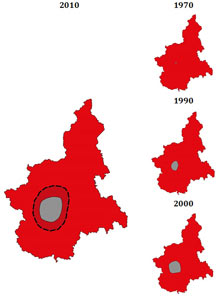TOP STORIES
Red squirrel populations wiped out in northern Italy
 |
| Grey squirrel spread and red squirrel extinction in Piedmont |
There are now no red squirrels left in an area of more than 1,150 square kilometres (sq km) in Piedmont, according to research from the universities of Turin, Genoa and Varese. On the edge of this large region, the species is also under threat from the incursions of grey squirrels.
...Grey squirrels were introduced into Italy relatively recently, in 1948. They were a gift from the US ambassador and kept in Turin, but escaped into the wild and rapidly colonised the surrounding area – despite warnings from the UK, where importing grey squirrels was forbidden from before the second world war, when the devastating effects of having imported greys in the 1880s had become clear.
Grey squirrels are not only more aggressive than the native European red squirrel, which causes them to invade red-dominated areas and take over, but they also carry a deadly virus, the squirrel pox. While greys are largely immune to the virus, it is lethal to red squirrels, which typically die within one or two weeks of being infected.
The Guardian - www.guardian.co.uk
27 Sep 2012
F Harvey
Location: Italy
Bird viruses under study pose no threat to humans
When ducks and geese stop in at the Lake Erie marshes for a rest or to catch dinner, they could pick up a case of the flu. Or, they might be leaving the virus behind for other birds to catch.
Two Ohio State University professors are studying waterfowl influenza in Lake Erie marshes in the Port Clinton area, including Ottawa National Wildlife Refuge in Benton Township and Magee Marsh state wildlife area in Carroll Township. They are examining what types of flu viruses lurk in the marshes, how long they survive, how they affect waterfowl and whether the spread of these viruses can be stopped.
"If a dangerous virus were introduced into North America by wild birds, we would have a model to use to assess the risks before the virus spread into or beyond the marshes in Ohio," Professor Richard Slemmons of OSU's Department of Veterinary Preventative Medicine said in an Ohio Sea Grant College Program article last year.
News-Messenger - www.thenews-messenger.com
25 Sep 2012
Location: Lake Erie, Port Clinton area, Ohio, USA
Tracking koala disease: New findings from old DNA
DNA extracted from the skins of koalas displayed in European and North American museums shows that a retrovirus has been a problem for the animals for much longer than was thought, according to Alfred Roca, an assistant professor of animal sciences at the University of Illinois, and Alex Greenwood of the Leibniz Institute for Zoo and Wildlife Research (LZW) in Berlin.
"The process by which a retrovirus invades the host germ line appears to be quite drawn out in this case, so that the koala population has suffered the strongly pathological effects of the virus for many generations," Roca said.
EurekAlert! - www.eurekalert.org
26 Sep 2012
A new lungworm discovered in Northern Canada’s caribou, muskox and moose
 |
| Dorsal Spine Larvae – Varestrongylus sp. Photo credit: Susan Kutz, Gui Verocai |
... Through molecular analysis of larvae isolated from feces of caribou, muskox and moose across Northern North America, Alberta regional CCWHC Director Dr. Susan Kutz from the University of Calgary Faculty of Veterinary Medicine, along with collaborators found that a previously undescribed lungworm species was infecting wild ungulates across most of arctic and subarctic North America. A name could not be given to this new species because adult worms were not isolated, and hence not formally described.
HealthyWildlife.ca - www.healthywildlife.ca
24 Sep
More News from HealthyWildlife.ca
OTHER WILDLIFE HEALTH NEWS
- Minke whale found on Northumberland beach dies [Northumberland, England, - Map It
 ]
] - 'Zombie bees' make first appearance in Washington state (Video) [View location of cases reported in the news in USA on Global Wildlife Disease News Map
 ]
] - Ocean Acidification Can Mess with a Fish's Mind [Scientific American]
- More Caves Must Be Closed To Slow Bat Epidemic Says Leading Scientific Organization [Cited Bioscience journal article HERE]
- The 'slippery slope to slime': Overgrown algae causing coral reef declines
- Studies from Wuhan Institute of Virology in the Area of Fish Diseases Described
| Whitetail Deer Deaths in Michigan, USA from E |
- Threatwatch: New killer virus in the Middle East
- Texas seeks to learn lessons from West Nile virus "disaster" [USA]
- Within reach of Australia: Rabies is now present only 350 kilometres from northern Australia
- Disease Detectives Catch Deadly African Virus Just As It Emerges
- West Nile Virus 'Stumps' CDC
- Deer-killing EHD virus could affect Michigan's hunting season
- DNR announces EHD now found in 24 counties [View cases reported in Michigan, USA on Global Wildlife Disease News Map
 ]
] - Endemic disease strikes northeast Wyoming white-tailed deer [Black Hills, Wyoming - Map It
 ]
] - EHD Confirmed in Dane, Sauk and Waukesha counties [View cases reported in Wisconsin, USA on Wildlife Disease News Map
 ]
] - IOWA CATTLE SICKENED BY EPIZOOTIC HEMORRHAGIC DISEASE (EHD)
- Lab tests tie deer deaths to EHD in 4 counties [View cases reported in the news in Indiana, USA on the Wildlife Disease News Map
 ]
] - Viral disease detected in N. Florida deer [Florida, USA - Map It
 ]
]
Huh?! That's Interesting!
- Google adds coral reef panoramas to Street View maps
- Eye in the Sky: Drones Help Conserve Sumatran Orangutans and Other Wildlife





No comments:
Post a Comment